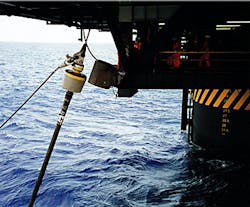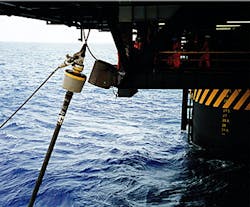DRILLING & PRODUCTION
William Furlow
Houston
This photo shows the pull-in of the SCR FlexJoint on the semisubmersible P-18 (Photo courtesy David Riggs, Oil States Special Products VP).
First steel catenary riser installed on FSO
Petrobras has incorporated a 10-in. steel catenary riser (SCR) into a floating production system (FPS) in 910 meters water depth. This is the first such application of an SCR. The riser is part of a 4-km. gas pipeline that connects two semisubmersibles: P-26 and P-18.Traditionally, these risers are made of flexible pipe so they can absorb the heavy motions experienced by floating vessels. While flexible pipe is more forgiving than steel in rough seas, it is also substantially more expensive. Previous SCRs were used on tension leg platforms (TLP).
This configuration was less of a technical challenge because, while there is some motion on a TLP, the rig does not heave. It is the compensation for the heave motion that presents the challenge in this design, according to Oil States Industries, which completed the installation. Also the riser motions on these rigs would be greater. Oil States combined its FlexJoint technology with the SCR design to overcome these limitations of the steel riser.
On this first installation, completed in September, Oil States installed instrumentation on the touchdown point, wave zone, and the FlexJoint itself to monitor riser stress, angles, and vortex induced vibrations. The data collected from this first application will be used to verify and calibrate analytical models that the company will draw from for future SCR designs.
Petrobras seems encouraged by the success of this prototype installation. Marcos Morais, Petrobras Subsea Technology Manager, said his company would like to see the technology applied to a floating production, storage, and offloading turret type unit.
Baker Oil Tool completes level six
Fresh from a recent Technology Advancement of Multilaterals (TAML) level five completion, Baker Oil Tools (BOT) has now raised the bar with a level six completion. Working with Shell Oil and AERA Energy, BOT completed the multilateral using a hydraulically sealed multilateral casing junction that allows two lateral sections to be drilled from a single main bore casing string.This new product is called the FORMation Junction. It is installed in a size that has an effective outer diameter that is less than the sum of the junction's two lateral casing legs. That means it can be installed through standard casing. Once downhole, it is reformed to full size using "mechanical and hydraulic means." This expansion process is a key proprietary technology that the company would not discuss in detail. It would seem to make use of the same technology Shell has exploited in its expandable casing research, except that the materials and processes used in formation reform rather than just expand.
In addition to eliminating the need for an oversized casing program, the new junction technology makes use of a variety of proven and traditional technologies and equipment. Alan MacKenzie, Manager of Multilateral Systems for BOT, said this is no accident. The purpose of the new design was to take the risk out of multilateral drilling and completion operations.
Although the primary benefit, the one that makes this a level six completion, is that the casing provides the pressure integrity of the junction, there are a number of others. Principal among these is the fact that the new junction design eliminates the hazard of metal debris created by the window cutting operation, necessary for creating traditional multilaterals that exit the casing string. This system uses traditional cementing methods and lateral drilling techniques, and because the junction is floated downhole in one piece, then expanded, it reduces the number of trips needed on a multilateral installation.
Since the FORMation Junction relies on standard technology, it takes a lot of the risk out of multilateral completions. MacKenzie said one of the goals of this project is to develop a manageable level of risk for multilateral drilling that is acceptable to operators. By using standard installation equipment and techniques, a standard casing program, and generating no metal debris, this new junction will simplify multilateral drilling and completion procedures.
While this first Level Six well was completed onshore, specifically at AERA Energy LLC's Belridge field in Bakersfield, Calif., MacKenzie estimates the technology will make its way offshore in the early part of 1999.
Deepwater multiphase pumps proliferate
At the recent Deep Offshore Technology Conference (DOT '98) in New Orleans, a number of companies were touting their new subsea multiphase booster systems. This technology, while not new, is gaining in popularity and reliability as it moves into deepwater. Two of these new products represent a snapshot of features and advantages that are making this technology so popular.Basically, these units use a twin screw pumping system that is not as sensitive as conventional pumps to fluid densities. This means the systems will displace large amounts of fluid even in wells with high gas content and water cut. These systems are also attractive because they can improve flow rates over the life of a well even though the composition of the fluid varies. The goal, of course, is to maximize production from marginal wells.
The new Wellamps system, developed by Westinghouse's Electro-Mechanical Division with the support of Petrobras, will be installed on the Marlim Field in the Campos Basin in 660 meters of water off Brazil. This system boasts the ability to improve flow rates without the need for any flow conditioning or gas separation. Westinghouse plans to develop a family of these systems for wells with a target flow rate to 250,000 boe/d, and boost pressure to 70+ bar.
This system features a clean, solid oil system for motor lubrication and flushing pump seals, gears, and bearings. It also features a pressurizer to create a positive pressure bias on the lube oil to prevent crude from packing across the pump seals. The system also uses a 6,900 kv canned motor. The high voltage eliminates the need for a subsea transformer. The use of cans to protect the rotor and stator provide extended motor life.
The Deepwater Multiphase Boosting System (DMBS), developed by Sasp, Sonsub, and Nuovo Pignone, is targeted to similar flow rates and boosting pressures at the Wellamps system. The DMBS features a novel pressure compensation system, making the system insensitive to the high pressure.
The whole system is pressure compensated at the process inlet by means of a pressure compensator that segregates the well fluids from the lube oil and auxiliary fluids by means of a patented membrane. The whole system including the auxiliary fluids, is compensated to the inlet pressure without any external dynamic barrier to the ambient pressure.
The lube oil that lubricates the bearings and flushes the mechanical seals is circulated by means of a circluation pump driven by the pump shaft providing a differential pressure of about 30 psi. In this way the differential pressure experienced by the mechanical seals is kept to a minimum and constant value of 30 psi. This gives a high level of reliability for the mechanical seal without overstressing. A special design allows low speed and limited load across the seals. The adopted subsea electric motor is a water filled squirrel cage electric motor which contributes to the efficiency of the overall system. This system was installed for Agip on the Prezioso Field in shallow water offshore Sicily, where it operated without incident for two years. While the Wellamps is a horizontal configuration, the DMBS is a vertical design. This makes deepwater installation and retrieval similar to that of a guidelineless christmas tree. It can be installed using a diving support vessel rather than requiring the mobilization of a rig.
Agip has contracted for the construction of one of these systems with a capacity of 240,000 b/d volume for delivery next year.
Copyright 1998 Oil & Gas Journal. All Rights Reserved.

